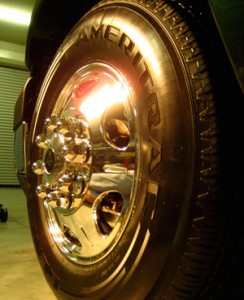 The next time you need to polish aluminum, chrome, or stainless steel, give Meguiar’s M015 Ultra-Cut Compound or Meguiar’s M205 Ultra Finishing Polish a shot. Before you blurt, “What?! That product is made for polishing paint, not metal!”, let’s think things through.
The next time you need to polish aluminum, chrome, or stainless steel, give Meguiar’s M015 Ultra-Cut Compound or Meguiar’s M205 Ultra Finishing Polish a shot. Before you blurt, “What?! That product is made for polishing paint, not metal!”, let’s think things through.
Metal polishes are available in liquid, paste, slurry, or bar form. Typically, metal polishes use abrasive grains to scrub metal away. The abrasive grains are mixed with all sorts of other ingredients, most of which are designed to keep the abrasives under some sort of control (so they won’t dust away).
Variations of grease, oil, animal fat, silicone, wax, (and other products) are used to act as a buffer of sorts, helping to minimize scouring of the freshly polished surface by floating or encapsulating the freshly abraded metal remnants. Finally, waxes, silicones, or polymers are designed to form a micro-barrier of protection in order to slow oxidation of the finely polished surface.
A big problem often arises when polishing metals via machine. As the surface is polished, the metal that is removed from the surface can attach to buffing wheels or pads (for this discussion, let’s assume we are using a rotary or random orbital polisher, paired with a wool, foam, or microfiber pad).
Since machines work so much more quickly than hand application, abraded metal residue can quickly gather on the pad, and scour or gouge an otherwise pristinely polished surface. Thanks to the greases, oils, silicones, and waxes, the residue is not easily removed from the pad, so unless you change them often, you will have a rather hard time achieving a perfect result.
Meguiar’s M105 Ultra-Cut Compound and Meguiar’s M205 Ultra finishing Polish aren’t thick and greasy. Yet, they contain abrasives that are more than capable of polishing aluminum, chrome, and stainless steel. Once these liquids start to dry or attach to the buffing pad, a spritz of water upon the polishing surface can loosen the abrasives from the pad, allowing you to use them for longer periods of time. The water helps to keep the pad pretty darned debris-free too, so scouring of the surface is greatly minimized.
Still, expect to see some scouring (because as metal is removed from the surface, it inevitably will scratch it). However, since the pads can be kept clean… you should clean them often. Use plenty of buffing liquid while you polish too, because the excess will help to float or encapsulate abraded residue. Most of the buffing liquid and metal residue will eventually fling away, which is a good thing.
Once you’ve done the heavy cutting with M105, use a fresh pad and M205. You will see a big difference in the final finish. Then, if you’d like to finish things off using a metal polish, give it a shot. I generally final polish using a fresh microfiber towel and M205 (flipping the towel almost constantly to avoid scouring). In my experience, the abrasive grains used in M205 are much finer than those used in most metal polishes. On several occasions when polishing softer metals (aluminum), I’ve had to re-polish (using M205 once again) after a metal polish left the surface in worse condition than the finish left behind by M205.
The only real drawback to using M105 or M205 to polish metal is… it can be a bit messy, especially if you use lots of water. For me, it’s worth the mess.
Other than that, use plenty of caution when polishing chrome. Chrome is very hard, but incredibly thin. Overdo it while machine polishing, and you’ll cut through the chrome, right down to the nickel coating underneath. M105 will truly eliminate scratching, which doesn’t usually happen when using chrome or metal polishes… but there is some risk involved. A keen eye and diligent inspection while you polish should keep damage at bay.
